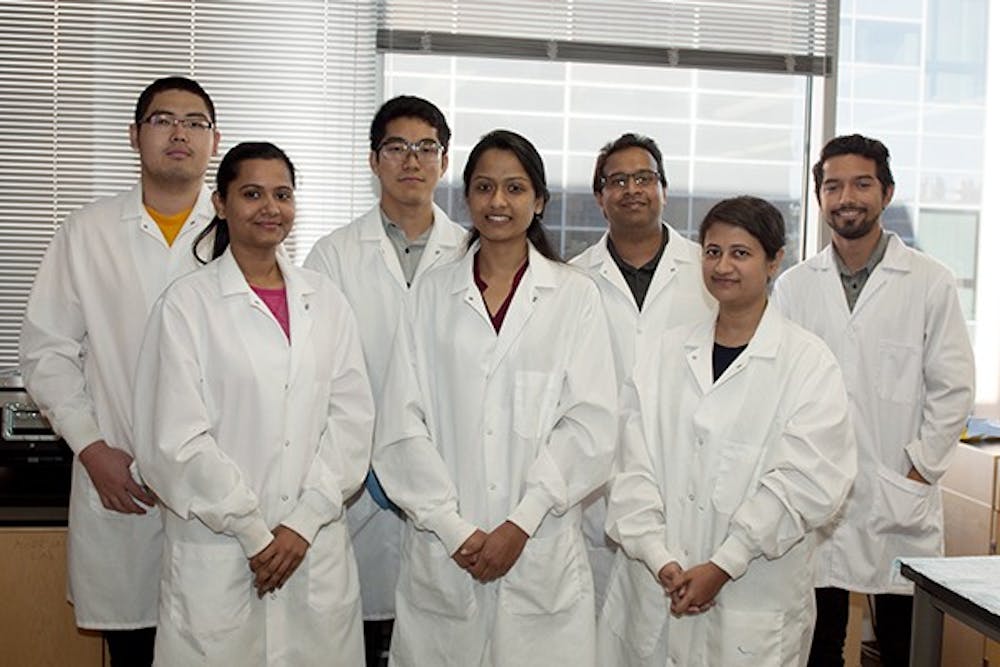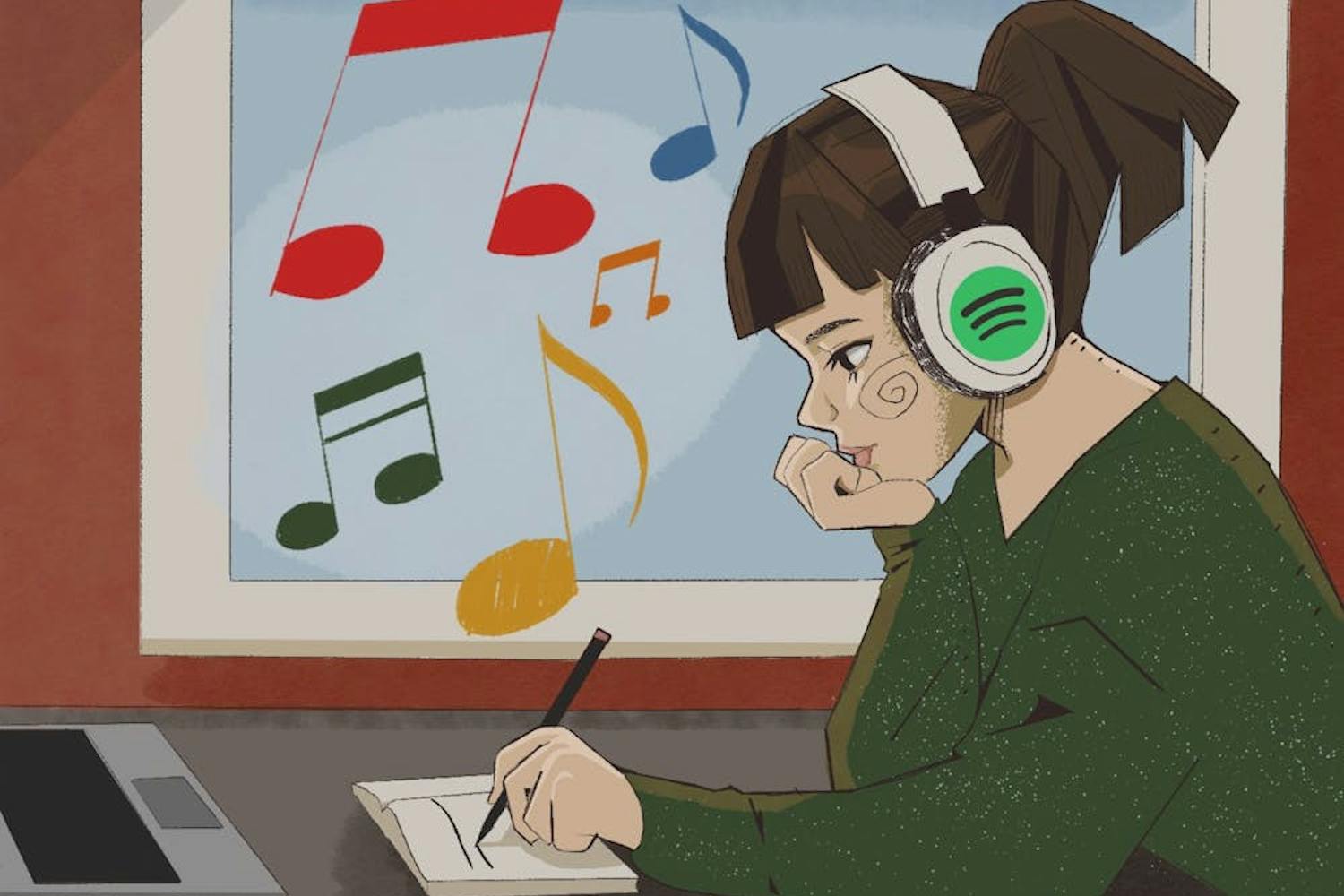 (Back row from left to right) Graduate biomedical engineering students Haiqing Wang and chemical engineering student Tyson Tsutsumi, Professor Vikram Kodibagkar, and undergraduate biomedical engineering student Carlos Renteria, (front row from left to right) biomedical doctoral students Shubhangi Agarwal, Vimala N. Bharadwaj, and Rohini Vidya Shankar, are part of a research team supported by the National Science Foundation. Exploring new imaging techniques, they aim to discern the correlation between aggressive tumors and oxygen deficiency in cells. (Photo by Mario Mendez)
(Back row from left to right) Graduate biomedical engineering students Haiqing Wang and chemical engineering student Tyson Tsutsumi, Professor Vikram Kodibagkar, and undergraduate biomedical engineering student Carlos Renteria, (front row from left to right) biomedical doctoral students Shubhangi Agarwal, Vimala N. Bharadwaj, and Rohini Vidya Shankar, are part of a research team supported by the National Science Foundation. Exploring new imaging techniques, they aim to discern the correlation between aggressive tumors and oxygen deficiency in cells. (Photo by Mario Mendez)
Cancer is expected to take the lives of more than 580,000 people living in the U.S. this year by Dec. 31, according to statistics from the National Cancer Institute’s Surveillance, Epidemiology and End Results Program.
Cancer is among the world’s most common health threats, and treatment of the disease often has unpleasant side effects, but ASU professor Vikram Kodibagkar has taken steps to improve cancer care by developing new magnetic resonance imaging techniques that could help better target radiation and chemotherapy treatments.
Kodibagkar is working to improve MRI technology so that it will more clearly identify hypoxic cells — cells deprived of normal oxygen levels — which pose a particular danger to cancer patients.
“The cells that are in the hypoxic regions, in a sense, are growing up in a bad neighborhood,” he said. “They turn out to be a little bit tougher.”
He said cancer cells that grow in hypoxic environments have to undergo certain changes due to oxygen deprivation that make them more adaptable. This enables them to spread faster and farther than cancer cells grown in non-hypoxic environments, making them especially vicious.
Kodibagkar has developed two ways to identify hypoxic cells in MRI scans, which he hopes will lead to more precise utilization of radiation to treat cancer and reduce unnecessary damage of healthy tissue.
Both of these techniques are still being developed and tested.
One technique Kodibagkar has developed works like fabric dye exposed to a patchwork of cloth and plastic, if oxygenated cells were plastic and hypoxic cells were cloth.
 Graduate chemical engineering student Tyson Tsutsumi is one of a handful of students whose work is funded by the National Science Foundation. Their research group, lead by Professor Vikram Kodibagkar, studies oxygen levels in cells and are exploring new imaging techniques for better observations. (Photo by Mario Mendez)
Graduate chemical engineering student Tyson Tsutsumi is one of a handful of students whose work is funded by the National Science Foundation. Their research group, lead by Professor Vikram Kodibagkar, studies oxygen levels in cells and are exploring new imaging techniques for better observations. (Photo by Mario Mendez)
Before scanning a patient with an MRI machine, a coloring agent is injected into an area of their tissue that may or may not contain hypoxic tissue. The agent passes over oxygenated cells, but if hypoxic cells are present, it adheres to them and makes them clearly visible in images taken by the MRI machine.
A separate technique is one that Kodibagkar called a “quantitative technique,” and it is used to measure the precise amount of oxygen in a selection of tissue.
To use the quantitative technique, Kodibagkar said he is able to inject a small amount of a siloxane-based probe into a patient’s tissues and then use a special MRI “pulse” he developed to read a signal from that probe. The magnetic resonance images produced by that process give him enough information to determine the oxygen levels of the tissues scanned.
“Through our research, we are able to obtain more information about how the therapy progresses for certain diseases, particularly cancer,” he said. “We are not only solving specific problems; we are expanding the boundaries of science."
He said he is exploring the mysteries or what actually goes on inside of a tumor, as well as solving problems like whether to choose therapy A or therapy B for a given cancer patient.
 Assistant Professor Vikram Kodibagkar (left) oversees biomedical doctoral student Shubhangi Agarwal as she preps an oxygen free chamber used to test and expose culture cells to imaging agents. Agarwal's work is emphatically supported by the National Science Foundation and hopes to expose light on the correlation between oxygen deficiency and aggressive tumors. (Photo by Mario Mendez)
Assistant Professor Vikram Kodibagkar (left) oversees biomedical doctoral student Shubhangi Agarwal as she preps an oxygen free chamber used to test and expose culture cells to imaging agents. Agarwal's work is emphatically supported by the National Science Foundation and hopes to expose light on the correlation between oxygen deficiency and aggressive tumors. (Photo by Mario Mendez)
Kodibagkar received a grant in May for $440,000 from the National Science Foundation to continue his research efforts, and he said he would enjoy doing so.
"What I like the most (about my work) is that it matches with my personality quite a bit,” he said. “What I love to do is solve problems, to try to unravel mysteries and to educate. My work allows me to do all of that.”
Marco Santello, director and professor at the School of Biological and Health Systems Engineering, said Kodibagkar was not only an exceptional researcher, but also an exceptional teacher.
“He is deeply committed to training students at all levels — high school, college and graduate — and spends a lot of time teaching and mentoring students,” he said in an email.
Santello said students were lucky to be able to work with Kodibagkar, whose research “has the potential to help refine and improve personalized therapy for cancer” and would likely be a routine part of cancer diagnostics in the future.
Mark Pagel is professor of biomedical engineering and chemistry at UA who studies tumor acidosis, a field he described as “very complementary” to Kodibagkar’s. Although they don’t work together on the same projects, Pagel said he was very familiar with Kodibagkar’s research.
“I think he’s leading the field,” Pagel said. “Measuring hypoxia is the holy grail of molecular imaging, especially for cancer molecular imaging. We’ve been searching for a method that can do this relatively easily, accurately and non-invasively, and he’s got a series of methods now that seem to be working out really well.”
Correction: Because of a reporting error, a previous version of this article had the wrong titles of Tyson Tsutsumi, Haiqing Wang and Carlos Renteria and misspelled names of Carlos Renteria, Vimala N. Bharadwaj and Shubhangi Agarwal in the photo captions. The article has been updated to reflect the correct titles and names.
Reach the reporter at megannphillips@asu.edu or follow her on Twitter @megannphillips
Like The State Press on Facebook and follow @statepress on Twitter.




